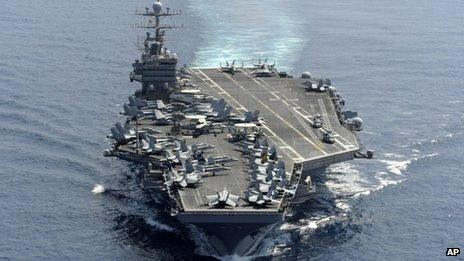Q&A: What are the 'sequester' budget cuts
- Published

The US Navy has delayed a long-planned overhaul of the aircraft carrier USS Abraham Lincoln as a result of the budget uncertainty
On Friday, a series of broad automatic budget cuts known in Washington DC as the sequester are expected to take effect, hitting many areas of the federal government if Congress does not act.
What is the sequester?
"Sequester" is Washington DC jargon for a series of spending cuts totalling $85bn (£56bn) this year and $1.2tn over 10 years. It is scheduled to take effect on Friday.
Why is it happening?
The cuts were created in negotiations over a 2011 bill that raised the US debt ceiling, the legal limit that America is allowed to borrow to fund its budget deficit.
Composed of blunt budget cuts across areas of key interest for both Democrats and Republicans, they were designed to be unappealing. They were meant less as a budget reduction tool and more as a cudgel to prod Congress to find a better way to plug America's roughly $1tn budget deficit.
Under the 2011 plan, the sequester would only take effect on 1 January 2013 if Congress failed to devise its own package of $1.2tn in deficit savings, whether through tax rises or budget cuts.
With the 2012 presidential election taking shape, Congress failed to act until 1 January 2013, in a deal that raised tax rates on incomes over $400,000 and postponed the sequester until 1 March.
What is to be cut?
The cuts are roughly evenly divided between military and domestic spending. Agency heads may not protect certain programmes deemed essential in order to take larger hits in other areas.
Many mandatory programmes like the Social Security pension programme, Medicaid healthcare for the poor, food aid, and others will not be affected.
In recent days, President Barack Obama and his cabinet officials have warned of harmful impacts on:
Medical research
Education budgets
Military readiness
Services to victims of domestic violence
Vaccines for children
Food safety, as meat inspectors are taken off the job
Queues at border crossings
Airline travel and aviation security
How bad will it be?
President Obama has warned the cuts will slow the US economy, eliminate jobs, and "leave many families who are already stretched to the limit scrambling to figure out what to do".
The Pentagon has also sounded the alarm, having already begun cutting 46,000 temporary workers and saying it will force staff to take one unpaid day off per week starting in April.
Some senior Republicans, meanwhile, are downplaying the threat.
"I don't believe the world will end," Senate Minority Leader Mitch McConnell said on Tuesday.
What will happen after the deadline?
The cuts to the federal budget will not hit all at once. Many actions planned by agencies cannot take effect immediately and the cuts will ramp up through the year.
The Republican-controlled House of Representatives has twice passed bills to replace the sequester with other cuts.
But many of the cuts included in the House bill are unacceptable to Senate Democrats and Mr Obama, who have unveiled their own proposals to replace the sequester with spending cuts and tax increases. Republicans say they will oppose any tax rises.
Correspondents say that many in Washington DC expect a deal will come after 1 March, as the outcome of the cuts becomes more apparent.
But another fiscal deadline looms in late March, when the continuing resolution that has served as the federal government's working budget for the past year expires.
If a new budget or temporary resolution is not in place by 27 March, much of the federal government will shut down.
- Published26 February 2013
- Published25 January 2013
- Published26 February 2013
- Published22 November 2011